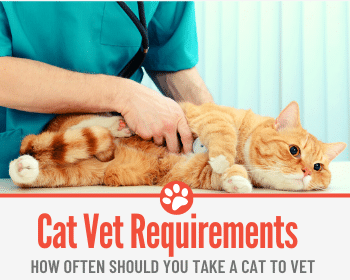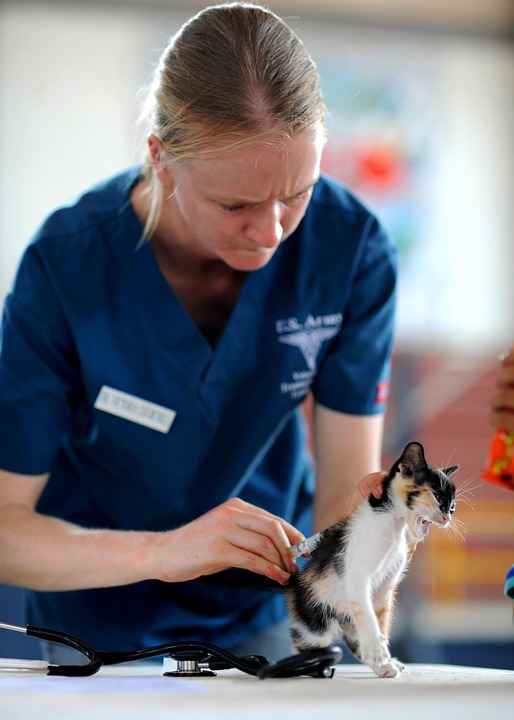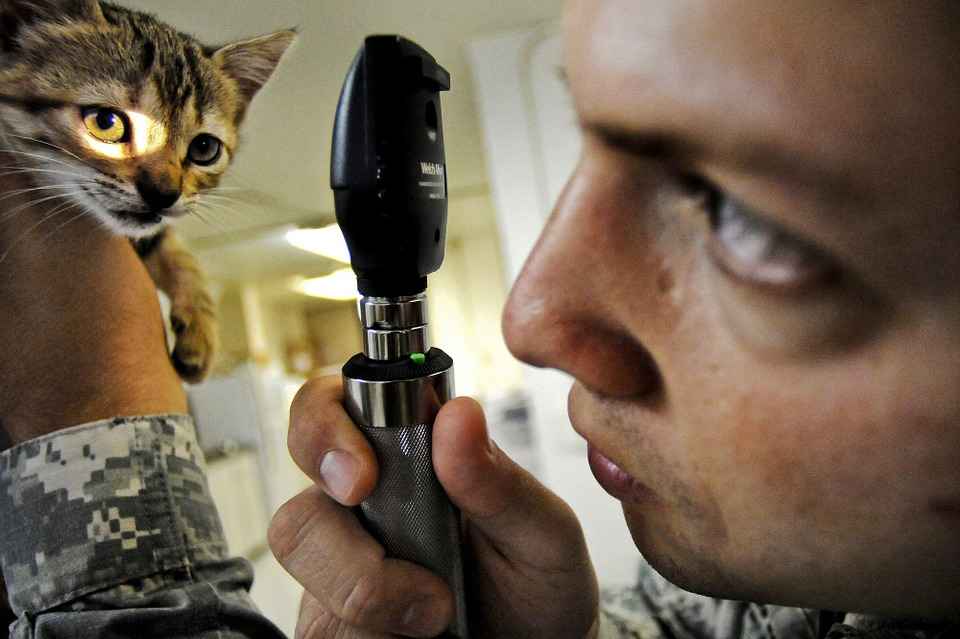 Are you like me, someone who got a kitten, took it to the vet to get all the necessary shots and a medical look-over, but since then has never been back? Is it bad to not take your cat to the vet?
Are you like me, someone who got a kitten, took it to the vet to get all the necessary shots and a medical look-over, but since then has never been back? Is it bad to not take your cat to the vet?
As humans, if we get sick we can book an appointment with our local doctor, but our feline friends don’t have that luxury.
Consider also that cats, like most animals, have an inbuilt mechanism to deal with pain and so don’t display that they are suffering the way we do. In the wild it would be perceived as a weakness, putting the animal in jeopardy.
So, how often do you take a cat to the vet?
To stay on top of their health and to make sure they are in tip-top shape, take your cat to the vet for yearly check-ups, as a minimum, and vaccinations make up an important part of that schedule. However, depending on their age and what’s going on they might need to be seen more often. Read on to find out how often to take a cat to vet and the reasons why
Kitten: Birth to 1 Year
There is no ‘too early’ for when to first take your kitten to the vet. Initial appointments will help you set out the coming year and when to next attend.
Until they are 16 weeks old, kittens need to be seen roughly every 3 to 4 weeks to get all the required vaccines and screening for other illnesses.
It is good to start heartworm and flea- and tick-prevention medications at this point, especially if there is a prevalence of those diseases in your area.
The check-ups also give the vet a chance to assess whether your pet is growing as expected and help with any problems from an early age. They might also advise on housebreaking, training, and socialization techniques.
It is likely that you will want to have your kitten neutered, and that happens around 6 months of age.
Adult: 1 to 7-10 Years (Depending on Type of Pet and Breed)
Once a cat reaches adulthood, check-ups can reduce to once per year. The appointments include a head-to-tail physical and booster vaccinations. If anything unusual is thrown up there might be further tests or blood analyses done.
It’s helpful to bring in a stool sample from your pet, which your vet will check for intestinal parasites.
Senior: 7 to 10 Years and Older
Like humans, as cats age they become more prone to disease and damage. It’s advised that you take your cat to the vet every 6 months from about 7 years onwards. The check-ups this time include further vaccinations and a physical exam. Blood and urine tests are likely and will give your vet an understanding as to how your pet’s kidney and liver are performing, thyroid hormone levels, and more.
Mention any changes you’ve seen in your pet. A change in mood, like becoming very listless, or physical changes, like drinking more than usual, will give the vet an indication as to whether something is not quite right.

What shots do cats need?
There is considerable debate – in cats, as well as in humans – as to whether vaccines are beneficial or bring added health complications. As a result, feline vaccinations can be bucketed into two categories:
- Core
- Non-core
The standards for cat vaccinations are set out by the Feline Vaccination Advisory Panel. This is a group of veterinary and scientific specialists in the field of feline understanding. Recommendations are based on thorough research and testing, and their guidance is backed by the American Association of Feline Practitioners.
We would advise to keep up to date with all core vaccinations and discuss the pros and cons of the other group with your vet. More information about the different vaccines is here below:
What are core cat vaccines?
These are for any cat, indoor or outdoor, and under any circumstances. Cover for four diseases fall into this category:
- Rabies
- Feline Rhinotracheitis Virus/Herpesvirus 1 (FVR/FHV-1)
- Feline Calicivirus (FCV)
- Feline Panleukopenia (FPV)
The reason these should be top of your list is that they are extremely infectious and are present worldwide. Young cats can be severely debilitated if they fall ill from any of these diseases. The vaccinations provide strong protection and because there is little risk associated with the vaccine, it is not worth missing out on getting them done.
Rabies Vaccine
Vaccination against rabies is important, not only because of the protection it provides the cat, but also because it can easily be passed on to humans and ultimately leads to death.
Cats do not typically carry the disease. However, if they are bitten and infected by another infected animal they become a danger to others. The virus will stay incubated for about two months, after which the cat quickly starts to become aggressive, confused and finally dies.
As rabies is a global problem it is advised that all cats are immunized against it. Although rabies is not actually on the AAFP advisory list, many countries demand it by law, because of the concern around safety to the public.
FVRCP Vaccine
Protection against the rest of the core diseases is through the FVRCP vaccine, which has the advantage of combining the three remaining vaccines into one, making it easier to administer as one shot.
FPV Vaccine
Feline panleukopenia, otherwise also called feline parvovirus, is very infectious and particularly dangerous in kittens.
The first symptoms are typically that the animal is low in energy and lacking in appetite. As the illness progresses the cat will suffer from diarrhea and vomiting. The virus kills off leukocytes (also known as white blood cells), and in doing so leaves the kitten even more prone to contracting other infections.
FHV-1 Vaccine
Feline herpesvirus, or feline rhinotracheitis virus, affects the lungs. Look out for nasal congestion, sneezing, nasal discharge, conjunctivitis, ulcers in the mouth and pneumonia.
The virus can remain dormant in the body, sitting in the nervous system. Even if the cat improves, the virus may reactivate if the cat is feeling stressed. No reinfection is required for these secondary infections.
FCV Vaccine
Feline calicivirus is a name for a collection of viruses that develop into a respiratory infection in the upper parts of the lungs. Symptoms include sneezing, nasal discharge and ulcers in the mouth.
FCV can also lead to chronic gingivitis/stomatitis – inflamed teeth and gums that can be extremely painful. The more aggressive strains cause hair to fall out and attack the skin. Hepatitis may develop and death is also a serious concern.
How often do cats need shots?
For a short while after birth, kittens remain protected from diseases by antibodies transferred from the mother. Once this immunity wears off they become very susceptible compared to older cats, because their internal protection mechanisms are not yet fully developed. This is why kittens under 6 months are the primary concern in terms of vaccinations.
The maternal antibodies can, however, get in the way of, or even block, the performance of vaccinations in the body. To deal with this kitten vaccinations are given every three weeks to a month, whilst the cat is under the age of about four to five months old.
Cats older than 16 weeks, where the medical history is not known, have their doses administered in double quantities roughly every month.
Booster vaccines happen 12 months after the first batch.
What are non-core cat vaccines?
This category of vaccines is cat- and circumstance-dependent. In this group are:
- Feline leukemia virus (FeLV)
- Chlamydophila felis
- Bordetella bronchiseptica
FeLV Vaccine
FeLV, the feline leukemia virus, is found in nearly every country. Transmission is via body fluids, such as the feces, saliva or urine. The virus is transmitted when a cat carrying the disease goes near another cat, for example, during grooming or whilst sharing bowls of food and drink.
In kittens the vaccine is classified as core, but non-core in older cats.
If a cat gets FeLV it is playing Russian roulette – in some cats the virus goes into a quiet state and the animal appears unaffected, but others don’t fare that well. Latency can last months to years, but can then evolve into a mixture of associated illnesses, including anemia, lymphoma or immunosuppression.
A summary of the vaccinations for cats by age group can be seen in Table 1:
Table 1: Vaccinations for Cats by Age Group
| Age | Core Vaccines | Non-core Vaccines |
| 6-8 weeks | FVRCP | FeLV* |
| 10-12 weeks | FVRCP | FeLV* |
| 14-16 weeks | FVRCP
Rabies |
FeLV* |
| 1-year booster
after initial series |
FVRCP
Rabies |
/ |
| Annual vaccines | Rabies** | FeLV
Bordetella (can be administered as early as 8 weeks) |
| 3-year vaccines | FVRCP
Rabies** |
/ |
* FeLV: highly recommended for kittens and optional for adult cats.
** Rabies: 3-year vs 1-year vaccine depending on state laws.

Do older cats need vaccinations?
Some illnesses cannot be managed with one vaccine and its booster jabs alone. Rabies, for example, requires repeat shots every three years.
For this reason, unless your cat has other illnesses that make it unadvisable, your feline friend will have regular trips to the vet and should continue to have its updated vaccinations well into old age.
What vaccines do indoor cats need?
You might assume that because your cat does not go outside it does not need the same immunizations as outdoor cats.
Unfortunately, you are wrong. All cats should be up to date with the core vaccination program. It is only the non-core category that may be tailored to the animal and owner’s circumstances and preferences.
Other circumstances when to take your cat to the vet
It goes without saying that if your cat has been in an accident, is not eating properly, is losing or gaining weight suddenly or behaving abnormally, you should take your cat to the vet immediately. Let the vet determine whether there is something to be concerned about and put steps in place to help your much-loved pet.
Related Questions:
Are there any side effects from vaccinating my cat?
There is always an element of risk when taking any medication, including vaccinations, but in these cases the benefits typically outweigh the dangers associated with the diseases. Negative reactions to these vaccines are low, at around 0.5 percent. Symptoms are rarely severe and reactions don’t last long. Side effects that are common include listlessness, fever and localized inflammation.
Anaphylactic reactions and fatalities are very rare, standing at roughly one case in 10,000 vaccines.
Some cats suffer from sarcomas that develop at the site of injection. The prevalence is at around one in 10,000 vaccines. The sarcomas can be treated relatively easily and are a risk worth taking, considering the benefits of having the vaccine.
Can you take a cat to the vet without a carrier?
There is no law stating that a cat must be brought to the vet’s in a carrier, but to be honest, why would you do that to yourself or the cat?! If the cat gets scared and jumps from your arms it might run off in an area it does not know and get lost. You might be near a street and it could run out in front of cars and get killed.
You might decide to drive, but a scared cat can go awry in the car, jumping on you, scratching and distracting you, when you should be keeping your eyes on the road. You will be liable if an accident happens under such circumstances.
When you reach the vet’s surgery it is likely that there will be other animals there, including dogs. Again, this could really scare your cat and cause it to behave in an unpredictable manner.
You might decide to put your cat on a harness and leash. I would still not recommend that as the cat is still quite mobile like that. Nor does it have the protection of the walls of the carrier, giving it a barrier between itself and other animals and somewhere to hide behind.
Being taken to the vet and prodded, pricked with vaccines and the rest is uncomfortable and frightening enough for your cat. Don’t make it worse by letting the cat become very anxious before it has even arrived.
To get your pet used to going in a carrier to travel to the vet, put the carrier out a couple of hours before leaving the house to let it familiarise itself with the new object. Place its food and toys in it to make it more inviting.
There are some cats though, like my last puss, that recognize the carrier and bolt. With this sort of temperament, I’d suggest locking all doors and windows before revealing the carrier and doing so only at the last minute. Still put toys and treats inside to make the experience a little more pleasant.
How much is a vet check-up for a cat?
There is no doubt that pets don’t come cheap.
Surgery is one of the more costly types of care you are probably going to have to fork out for. Having your cat neutered or spayed is between $100 to $200. You could be looking at a bill of between $200 and $300 for blood tests, and easily double that for X-rays. Other surgical treatments can easily reach $2000.


